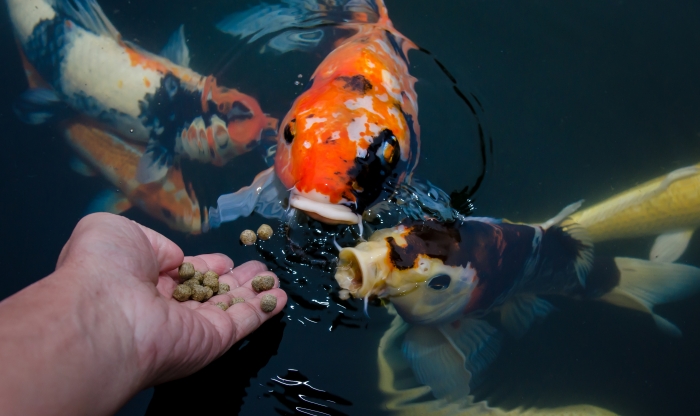
The best part of owning a pond? The fish, of course! No matter if you have koi, shubunkin or goldfish, feeding time is always a great time. You can even train fish to eat out of your hand.
However, you need to watch out you’re not having TOO much fun feeding your fish. Too much food is not good for fish, for a number of reasons. How, why and what to feed your fish? Read on for more!
How Much Is Just Right?
Overfeeding can make your fish sick, and excessive amounts of fish waste strains the limits of what can be biologically reduced in the pond, resulting in a decline of water quality. Fish should be fed no more than once a day. We recommend being wary of bacterial blooms (cloudy water and low oxygen levels) if you feed heavy and there’s a lot of fish waste.
Pond fish should be fed for about two minutes per feeding. If they don’t come up and eat voraciously, they are telling you that they are too cold, too warm, or they’re simply not hungry. If this is the case, feed them lightly. If they are eating like crazy, you can sprinkle food on the water for two minutes if fish are present and eating. Avoiding feeding so much that there is an excess of food left to float into the skimmer or filter.
Can you feed your fish too little?
Let’s start with underfeeding—the opposite problem to overfeeding them! Life gets busy and for many of us, the day gets away from us. What happens when we forget to feed our fish? This could impact very large fish in the summer when they could lose weight since their metabolism is working without enough calories for their big bodies. Underfeeding can also cause stunted growth in very small fish.
Fish in ponds with natural plant materials and other natural forage are better able to deal with lack of owner-provided food. This is why it is good to have some algae in the pond. The fish eat off the algae as part of the natural pond ecosystem. However, for larger fish and during the summer months it’s good to remember to feed your fish. This helps prevent them from eating your nice pond plants too!
If your fish are growing about one-half to one inch per month, you’re feeding enough. If not, they are either underfed, their pond home is too small, or the food is not adequate to support growth. Signs of underfeeding include heads that are wider than the bodies, slightly sunken eyes, a kink at the base of the tail, poor color, thinness, training white stools, and inactivity.
In the day-to-day experience of pond keeping, where you feed your fish can be significant. Unfortunately, many people feed the fish all at once near the skimmer. As a result, most of the food gets consumed by the skimmer instead of the fish. Your pond water can become polluted when food is left in the skimmer to decay, which isn’t good for your finned friends.
To keep your fish food from migrating to your skimmer, you can make a “feeding ring” out of two-inch PVC pipe and four elbows. This is simply a square ring of PVC with water secluded from inside, so it floats while retaining the food. The ring can be held in place with a string anchored under a rock. Your fish will learn to eat the food that’s floating in the ring.
Size Matters
Small fish need small pellets that they can eat all at once. If they get larger pieces of food they have to chase the food around the top of the pond to get bites as it softens in the water. Smaller bites (like for humans!) is better for fish as they can eat them quickly and safely in one bite.
Proper Food Storage
Ideally, you should only keep fish food for one season and dispose of any uneaten food. Always start a new pond season with fresh fish food. If you buy large quantities of fish food, refrigerate it – don’t freeze it. Freezing damages the fats in the food and the fat-soluble vitamins become compromised.
If food begins to smell funny, develops a fuzz on it, changes color, sticks together, or crumbles down, it’s “bad” and should be discarded. Feeding bad food to your fish can cause unnecessary problems. Bad food often contains aflatoxins, which can cause injury, deficiency, and broken backs in fish that eat it. It’s better for your fish to go hungry while waiting for fresh food, than it is for them to be fed spoiled food.
